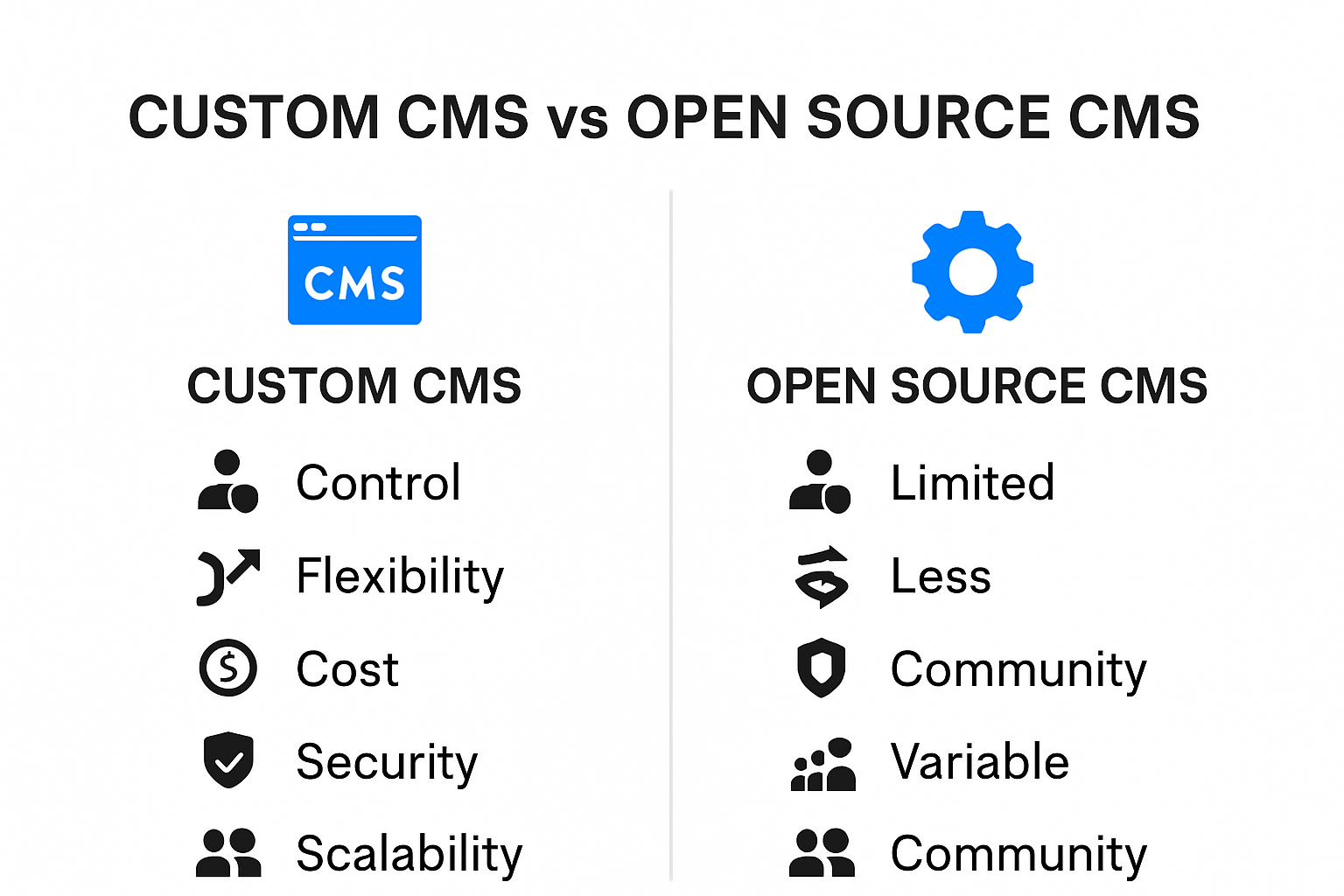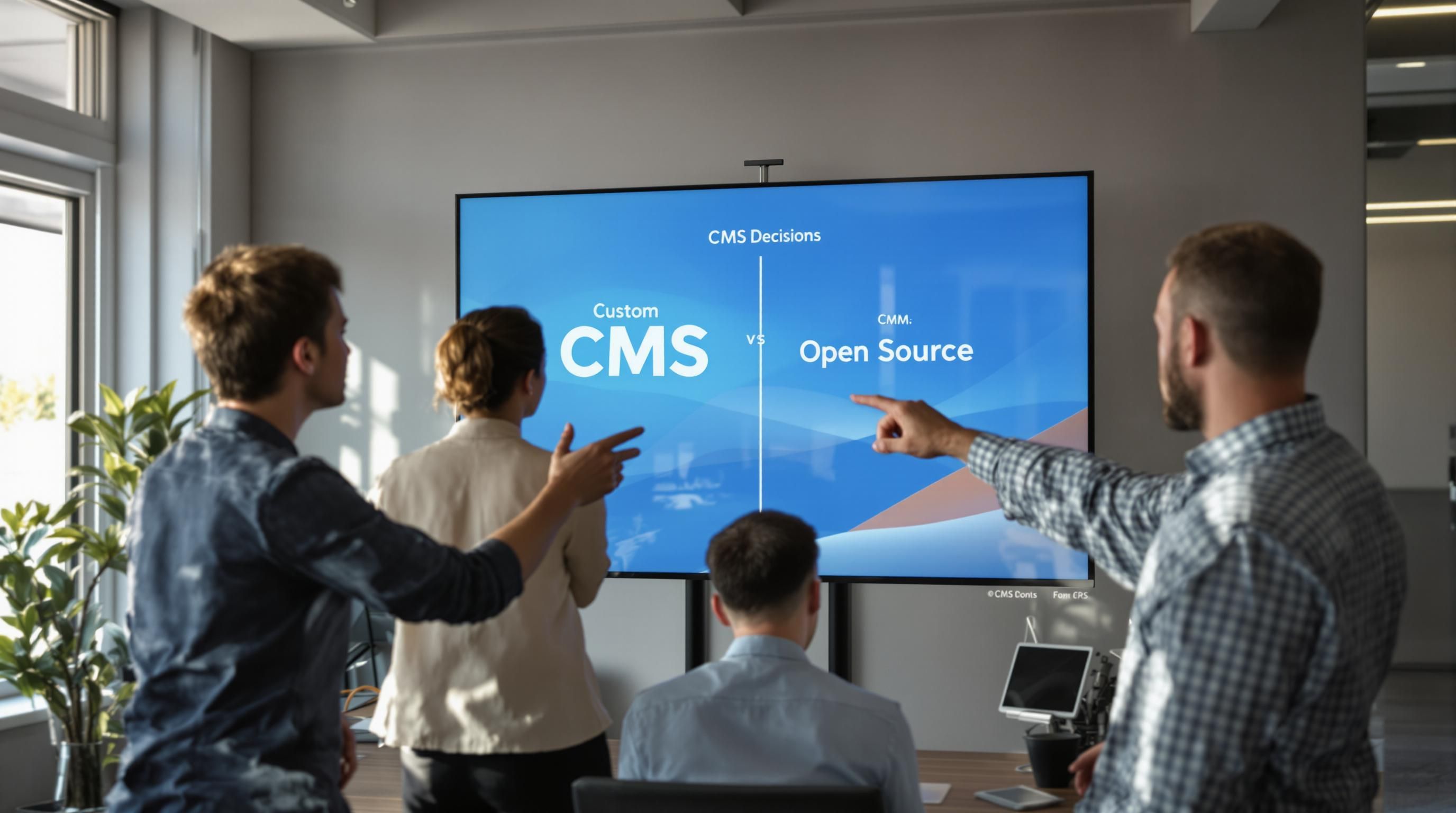Custom CMS vs Open Source: Best Choice for Businesses 2025
Picking a content management system can feel like a make-or-break move for any business. Most people think open-source platforms like WordPress are a no-brainer since they power about 43% of all websites worldwide. But what if relying on that popularity actually increases your exposure to security threats, especially with a 98% yearly spike in open-source vulnerabilities ? That single statistic flips the script and shows why custom CMS solutions are gaining ground among organizations that care about full control, specialized security, and long-term growth.
Table of Contents
- Comparing Custom CMS And Open Source
- Cost, Security, And Scalability Factors
- Choosing The Best CMS For Your Business
Quick Summary
| Takeaway | Explanation |
|---|---|
| Custom CMS offers tailored solutions. | It provides flexibility specific to organizational needs, ensuring better alignment with unique workflows and user experiences. |
| Open-source platforms enable rapid deployment. | They come with pre-built frameworks that facilitate quicker setup and wide community support for ongoing improvements. |
| Evaluate total cost of ownership carefully. | Custom systems often have high initial costs, while open-source solutions may incur hidden expenses over time. |
| Prioritize security in CMS selection. | Custom solutions often feature enhanced security protocols, while open-source platforms require regular updates to manage vulnerabilities effectively. |
| Assess scalability potential for future growth. | Custom CMS can be optimized for projected growth, while open-source might face complexities as needs evolve. |
Comparing Custom CMS and Open Source
Businesses navigating digital infrastructure face a critical decision when selecting a content management system. The choice between a custom CMS and open-source platforms represents more than a technical selection - it’s a strategic decision that impacts digital capabilities, budget, and organizational flexibility.

Architectural Differences and Flexibility
Custom CMS solutions offer unparalleled architectural flexibility tailored precisely to an organization’s unique requirements. Unlike standard open-source platforms, custom systems are built from the ground up to match specific workflows, integration needs, and user experience expectations. According to a study by Promet Source , 52.4% of organizations prefer proprietary solutions, highlighting the appeal of purpose-built digital infrastructure.
Open-source platforms like WordPress, Drupal, and Joomla provide a different approach. These systems come with pre-built frameworks and extensive plugin ecosystems that enable rapid deployment and standard functionality. Research comparing Drupal and SharePoint reveals that open-source solutions offer robust customization through modules, content types, and flexible taxonomies.
Performance and Scalability Considerations
Performance metrics differ significantly between custom and open-source CMS approaches. Custom solutions can be optimized for specific server configurations, database structures, and traffic patterns, potentially delivering superior performance for complex business requirements. Open-source platforms, while versatile, might require additional optimization and performance tuning to match custom-built systems.
Scalability presents another critical evaluation point. Custom CMS architectures can be designed with precise scaling mechanisms aligned with anticipated growth trajectories. Open-source platforms offer scalability through plugins and extensions but may introduce complexity as organizational needs evolve. Businesses must carefully assess anticipated digital transformation requirements when selecting their content management strategy.

The decision between custom CMS and open-source platforms ultimately depends on multiple factors: budget constraints, technical expertise, specific business requirements, and long-term digital strategy. While custom solutions provide maximum control and specificity, open-source platforms offer rapid deployment and community-driven innovation. Successful digital transformation requires a nuanced understanding of these architectural trade-offs.
Here is a comparison table summarizing the key differences between Custom CMS and Open Source CMS, as discussed in the previous sections:
| Aspect | Custom CMS | Open Source CMS |
|---|---|---|
| Architectural Flexibility | Highly tailored to unique business needs | Standard frameworks with customizable plugins |
| Initial Cost | High ($20,000 - $100,000+) | Low/Free (core); costs for extensions/maintenance |
| Deployment Speed | Slower, requires full development | Rapid deployment with pre-built solutions |
| Security | Unique designs, less targeted, enhanced protocols | Dependent on updates; open vulnerabilities |
| Scalability | Built for anticipated growth & optimization | Modular, but increased complexity as needs grow |
| Community Support | Limited (proprietary/team-based) | Broad, community-driven support |
| Maintenance | Handled by internal/contract teams | Community patches, ongoing plugin management |
Cost, Security, and Scalability Factors
Selecting a content management system involves navigating complex considerations beyond basic functionality. Cost, security, and scalability emerge as critical decision drivers that can significantly impact an organization’s digital strategy and long-term technological resilience.
Economic Implications and Total Cost of Ownership
The financial landscape of CMS selection extends far beyond initial development expenses. Custom CMS solutions often require substantial upfront investment, with development costs potentially ranging from $20,000 to $100,000 depending on complexity. These expenses encompass initial design, specialized programming, and comprehensive testing. While the initial outlay appears steep, custom solutions provide precise alignment with unique business requirements.
Open-source platforms present a contrasting economic model. Initial implementation costs are substantially lower, with many platforms offering free core software. However, Carnegie Mellon University cautions that total cost of ownership includes ongoing maintenance, security updates, and potential plugin or extension expenses. Organizations must factor in long-term support, potential customization needs, and the potential hidden costs of managing an open-source infrastructure.
Security Landscape and Vulnerability Management
Security represents a paramount concern in digital infrastructure selection. Open-source platforms offer transparency through community-driven development, but this approach is not without risks. A comprehensive study investigating security challenges revealed a startling 98% annual increase in reported vulnerabilities within open-source software. This statistic underscores the critical importance of robust security protocols and consistent maintenance.
Custom CMS solutions provide enhanced security through unique architectural designs that are less susceptible to widespread vulnerability exploits. By developing proprietary systems with specialized security frameworks, organizations can implement multi-layered protection strategies tailored to their specific risk profile. These custom solutions enable granular access controls, advanced encryption mechanisms, and proactive threat monitoring that generic platforms might not support.
To highlight the security and cost considerations discussed, the following table summarizes key statistics and insights:
| Statistic / Factor | Custom CMS | Open Source CMS |
|---|---|---|
| Typical Initial Cost | $20,000 - $100,000+ | Free (core); add-on fees |
| Yearly Increase in Vulnerabilities | Unique (not widely reported) | 98%* |
| Maintenance Responsibility | Internal/contract team | Organization & community |
| Security Protocols | Advanced, bespoke | Requires regular updates |
| Risk of Widespread Exploits | Lower | Higher, public vulnerabilities |
| Long-term Support | Custom/planned | Dependent on community |
*98% figure based on annual increase in open-source software vulnerabilities.
Scalability and Future-Proofing Digital Infrastructure
Scalability determines an organization’s ability to adapt and grow without significant technological reinvestment. Open-source platforms offer modular expansion through plugins and extensions, enabling incremental growth. However, this approach can introduce complexity and potential performance bottlenecks as system complexity increases.
Custom CMS architectures provide superior scalability by being designed explicitly around anticipated organizational growth trajectories. Development teams can engineer precise scaling mechanisms, optimize database interactions, and create flexible infrastructures that seamlessly accommodate increasing user demands, content volumes, and computational requirements.
Ultimately, the choice between custom and open-source CMS transcends technical specifications. Successful digital strategy demands a holistic evaluation of economic constraints, security requirements, and future scalability potential. Organizations must conduct thorough assessments, considering their unique operational context, technical expertise, and long-term digital transformation objectives.
Choosing the Best CMS for Your Business
Selecting the ideal content management system requires a strategic approach that goes beyond surface-level comparisons. Businesses must conduct a comprehensive evaluation that aligns technological capabilities with specific organizational objectives and constraints.
Strategic Assessment Framework
The process of choosing between custom and open-source CMS platforms demands a multifaceted analysis. Business Requirements emerge as the primary consideration, encompassing factors like industry specificity, user experience expectations, and integration needs. Research from the Centers for Medicare & Medicaid Services recommends adopting solutions that balance out-of-the-box functionality with minimal customization requirements.
Key evaluation criteria should include:
- Complexity of Business Processes : Determine whether standard open-source solutions can accommodate unique workflow requirements
- Technical Expertise : Assess internal team’s capability to manage and customize the chosen platform
- Budget Constraints : Compare long-term investment requirements for custom versus open-source solutions
- Scalability Potential : Project future growth and technological adaptation needs
Security and Sustainability Considerations
Security represents a critical decision factor in CMS selection. A comprehensive study on CMS vulnerabilities reveals that even popular platforms can harbor significant security risks if not properly maintained. Open-source solutions offer transparency but require consistent updates and proactive management.
The sustainability of the chosen platform becomes equally important. Research examining open-source licensing models highlights the challenges faced by community-driven projects in maintaining long-term development and support. Businesses must evaluate not just current capabilities but the projected longevity and community support of their chosen CMS.
Implementation and Transition Strategy
Successful CMS adoption extends beyond initial selection. Organizations must develop a comprehensive implementation strategy that minimizes disruption and maximizes technological integration. This involves careful planning of data migration, user training, and potential phased rollout approaches.
Custom CMS solutions offer maximum control but require significant upfront investment in design and development. Open-source platforms provide faster deployment and extensive community support but may introduce compromises in specific functionality. The optimal choice depends on a nuanced understanding of an organization’s unique digital ecosystem.
Ultimately, the most effective CMS is one that seamlessly aligns with business objectives, provides robust security, supports future growth, and enables efficient content management. Businesses should approach this decision as a strategic investment in their digital infrastructure, conducting thorough research, consulting with technical experts, and maintaining flexibility for future technological adaptations.
Frequently Asked Questions
What is a Custom CMS?
Custom CMS (Content Management System) refers to a tailored solution built specifically to meet the unique requirements and workflows of an organization, offering greater flexibility and control.
What are the advantages of using an Open Source CMS?
Open Source CMS platforms, like WordPress or Drupal, offer rapid deployment, extensive community support, and often lower initial costs, making them an attractive option for many businesses.
How do Custom CMS and Open Source CMS differ in terms of security?
Custom CMS solutions generally provide enhanced security through unique architectural designs and specialized security protocols, while Open Source CMS platforms may be subject to vulnerabilities that require regular updates and maintenance.
Which type of CMS is better for scalability?
Custom CMS is typically designed with specific scaling mechanisms to accommodate anticipated growth, whereas Open Source CMS can offer modular expansion but may introduce complexity as demands increase.
Ready for a CMS Solution That Truly Fits Your Business?
Choosing between a custom CMS and open-source options can feel overwhelming, especially when security, scalability, and efficiency are at stake. Many businesses outgrow generic platforms or face hidden costs and vulnerabilities they did not anticipate. You need a digital partner who can deliver tailored solutions and guide you through these critical decisions with real expertise.

Let TRAVLRD handle your digital transformation. From modern, conversion-focused websites to fully custom software that matches your workflow precisely, our team builds solutions designed to elevate your business above the competition. Visit TRAVLRD today and request a free consultation. Discover how quickly we can help you move past technological limits and toward secure, long-term growth.







